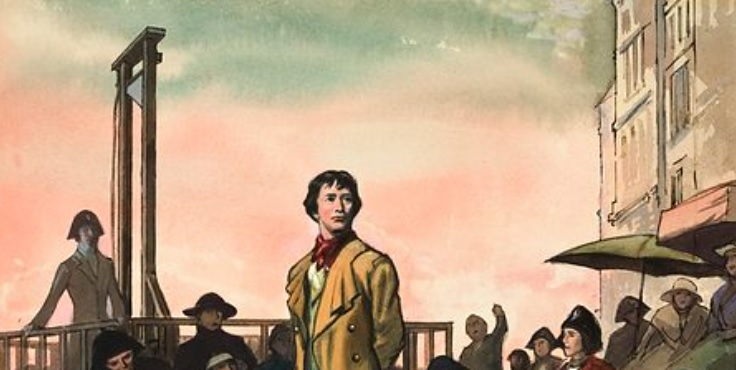
Stephen
Terry, Director
 ;
;

A
City Called Confusion
Commentary
for the May 27, 2023, Sabbath School Lesson
 "One of the seven angels who had the
seven bowls full of the seven last plagues came and said to me, 'Come, I will
show you the bride, the wife of the Lamb.' And he carried me away in the Spirit
to a mountain great and high, and showed me the Holy City, Jerusalem, coming
down out of heaven from God." Revelation 21:9-10, NIV
"One of the seven angels who had the
seven bowls full of the seven last plagues came and said to me, 'Come, I will
show you the bride, the wife of the Lamb.' And he carried me away in the Spirit
to a mountain great and high, and showed me the Holy City, Jerusalem, coming
down out of heaven from God." Revelation 21:9-10, NIV
In
1859, two years before the American Civil War, Charles Dickens published a
novel, "A Tale of Two Cities," set in the milieu of the French Revolution that had
taken place seventy years prior. In his novel, an English barrister, Sydney
Carton, dissolute and disillusioned with life becomes acquainted with Charles
Darnay. Using an alias, Charles has nonetheless been recognized, during the
Reign of Terror, as a member of the French nobility, a St. Evrémonde. Denounced and imprisoned, Charles is to be sent to
the guillotine. However, Sydney's unrequited love for Charles' wife, Lucie, and
his close resemblance to Charles, brings him to decide to forsake the safety of
London and travel to Paris, the titular two cities, where he switches places
with Charles and while he accepts the guillotine in place of the nobleman,
Charles and Lucie find safety in London. During his sacrifice, he intones one
of the most famous quotes to be found in literature: "It is a far, far better
thing that I do, than I have ever done; it is a far, far better rest that I go
to than I have ever known."
Some have called "A Tale of Two Cities," the
greatest novel ever written. This is not surprising for it echoes elements of
the greatest story ever told, a story that was retold in a 1965 movie of the
same name, starring Max von Sydow. The movie explores
the biblical sacrifice, where an innocent Jesus died upon a cross to save others
from eternal death. Some may question any equivalency between Sydney and Jesus.
But Jesus was also seen by his critics as dissolute in his day.[i] Man tends to
judge others based on appearances[ii] that may
reveal little to nothing of the state of the heart. Sydney's sacrifice was
driven by his love for Lucie. Jesus' sacrifice was also driven by love, a love
that, like Sydney's, is often unrequited as well. Because God created us in his
image, to love and be loved, stories like this appeal to something deep within
us. We are challenged with the question whether we would do the same for
another, or conversely, whether anyone would love us enough to make such a
sacrifice on our behalf. The New Testament assures us that is what Jesus did.
It challenges us in a way that a novel can never achieve. When fantasy becomes
reality, it is no longer just a story, not even the greatest story. It becomes
an indictment of us and our choices to know that someone rose to a higher morality
than we have ever invoked.
The similarities do not end there. The entire Bible,
although a disparate collection of stories, is essentially a tale of two cities,
Babylon and Jerusalem. According to Genesis, Babylon or Babel, depending on the translation, was established
by Nimrod of the second generation born after the flood.[iii] He was the son
of Cush, the son of Ham, the son of Noah. This was the Tower of Babel where the
Bible tells us the languages were born.[iv] Hence the city
Babylon became associated with confusion from all the different languages. It
is significant to note that the city of Ur, where the Bible tells us Abram was
from, was part of the Babylonian realm under Nimrod. Some Jewish sources
present the idea that Terah, Abram's father, was a
high-ranking supporter of Nimrod.[v] Because of our
limited life spans and our definition of time spans between generations, this
does not seem likely. However, if we examine the biblical record consistent with
the life spans claimed for that period, what seemed impossible becomes
plausible. Though traceable back to Cain and Abel, the conflict between good
and evil symbolized by the two cities represented by Jerusalem and Babylon,
seems to show the genesis of that symbolism with Nimrod and with Terah and Abram's departure from the Babylonian realm.
The Bible does not tell us when Jerusalem was
founded, but various archaeological sources reveal possibilities as early as
the 19th century BCE. While it may be even earlier, no evidence for
that has been discovered to date. The 19th century date is based on
execration writings listing Egypt's enemies from that period. Although such
texts go back to the 23rd century BCE, writing that could confirm
the existence of Jerusalem has thus far only been found from the 19th.
When the Bible mentions Jerusalem, it is referred to as Jebusite city. The
Jebusites, like Nimrod were descendants of Ham, but through Canaan rather than
Cush. They would have been cousins to Nimrod. In any event, Jerusalem remained
a Jebusite city until the time of King David when he conquered the city for
Israel, and a temple was built to house the various holy objects from the
wilderness tabernacle, including the Ark of the Covenant. At that point,
Jerusalem became established as the City of God. Despite the heady idealism of
that reputation, Jerusalem has seen much ungodliness perpetrated in her
streets. From the widespread blood shedding of King Manasseh to the murder of
Jesus. It is hard to derive a representation of the loving character of God
from such atrocities. Even more recently, during the Crusades, when Christians
took Jerusalem, they slaughtered Jews and Muslims alike, setting alight fires
of hatred and revenge that still reverberate today. With such a foundation,
there is little wonder that Jerusalem seems anything but the love of God to
many.
Despite the failure of so many believers to manifest
love and compassion for others, things they sometimes do not even display to
one another, a thread of connection to the presence of God remains, at times
glowing brightly through the prophecies of the Old Testament and their apparent
fulfillment, the words of Jesus, and the highly symbolized promises of Revelation.
We should be careful of our understanding of that, however. We have a narcissistic
tendency to conflate some of the symbolism for self-serving purposes. For
instance, it is too often said that the prophetic symbolism of a woman in the Bible
is the church, even to the extent of portraying the church as the bride of
Christ, something the Bible never says. The Bible says that the New Jerusalem is the
bride of Christ as in our opening text, not the church. It is the height of
effrontery to claim that one's dogma makes their church the bride of Christ. If
we were to construct a Venn Diagram for those inside any particular
denomination and those outside of it, we may find a point where both
intersect as eventual inhabitants of the New Jerusalem, but it is highly
unlikely that any denomination would be congruent with the New Jerusalem in
such a diagram. We may not realize it, but we even admit this when as a denomination,
we establish processes for church discipline. If sainthood were established by
denominational affiliation, such processes would not be necessary.
This symbolism path has some claiming that a white, radiant
woman, such as we find in Revelation, chapter 12, represents God's true church,
and the scarlet and purple clad woman of Revelation represents an apostate
church, an appellation conveniently applied to any group of believers who do
not adhere to the dogma of the denomination doing the interpreting. Such vilification
is often the precursor to persecution. Centuries of government sanctioned
persecutions by both Catholics and Protestants, depending on which power
controlled the government is a primary reason for the Establishment Clause in
the United States' Constitution, prohibiting the government from backing one religion
or sect over another. This is a source of frustration for those who believe that
their dogma is the "truth," and all others are
apostates who will be ultimately destroyed even if they cannot be touched now because
of a democratically elected government that either is apostate itself or simply
doesn't understand how apostates should be dealt with. While those winds of
strife are restrained for now, Revelation indicates they will not be held back
forever.[vi] Even today the
triple threat of Dominionism, Triumphalism, and
Nationalism are joining hands to bring about a Christian Fundamentalist heaven
on earth. They do not understand that the very processes they are engaging in to
accomplish this negates the need for any New Jerusalem or new earth as foretold
in Revelation. It also ignores the promise that the earth and the works up
until the Parousia will be destroyed. To what end will
their works be then? This is why Jesus spoke so much
about love. Love is impervious to flames. It persists despite apocalyptic
challenges.[vii] It persists despite
persecution. When we look at the various governments now in existence, no
matter what type of government people are under, in diverse locations and
through varied means, love continues. That is why the Bible and novels like "A
Tale of Two Cities" touch us. Love endures.